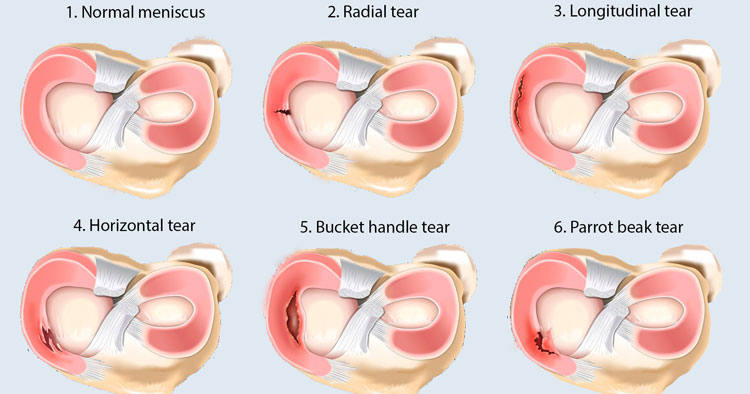Back and Joint Pain, Sports Injuries and Management
Types Of Meniscus Tear And Their Diagnosis
Traumatic Meniscal Tears
There are several types of meniscus tear and these can vary in a number of variables including size, severity and tear pattern. The exact type of tear is often indicative for the recovery following injury and any necessity for surgical intervention, as well as the potential development of future degenerative symptoms in the knee joint. Tears to the meniscus are either the result of an excessive force applied to a ‘normal’ meniscus or a normal force acting on a degenerative meniscus. The difference between the acute traumatic tear and the degenerative meniscal tear.
- Acute tears – Are typically occurring in the younger individual and the result of a trauma or sports injury. In these acute tears the types of meniscal tears vary and have can have a number of different shapes.
- Chronic tears – Occur in the older population and these tears are degenerative in nature often resulting from minimal trauma. Chronic tears are frequently challenging to repair surgically and often successfully treated conservatively with physiotherapy, medication and time.
Variations in meniscus tears seen in acute tears as mentioned include variations in tear length, tear depth and tear pattern. Some common types of meniscus tear patterns include:
- Longitudinal Tears: These tears run nearly the entire length of the meniscus and often result in a flap that subsequently can cause locking of the knee. If a longitudinal tear extends it may result in what is referred to as a bucket-handle tear due to its presentation looking like that of a bucket handle.
- Horizontal Tear: This type of tear occurs at the inner edge of the meniscus and may form a part of more complex “cracks” in the meniscus.
- Flap tear – Can be either horizontal and vertical flap tears. Depending on location and size a flap tear can lead to locking or catching sensation in the knee.
- Radial tear – These tears begin at the inner edge of the meniscus deep in the knee and continue outwards towards the capsule. Radial tears are seen to typically occur in the middle part of the meniscus not so much towards the poles.
- Complex tear – Complex tear patterns are tears in different planes. These types of meniscus tear are often a feature of a degenerative meniscus and due to their multi-plane nature are challenging to surgical repair.
Diagnosing A Meniscus Tear
A history of events coupled with physical examination of the knee can frequently diagnose or at least lead to a suspicion of a meniscal tear diagnosis. However these days often imaging is used to help confirm diagnosis and exclude any other coexisting pathology, or differential diagnosis. X-rays can be useful in ruling out fractures, osteoarthritis and other potential bony causes of symptoms, however X-rays do not have the ability to diagnose a meniscus tear. An MRI allows a more detailed evaluation of the knee cartilage and is generally considered the most detailed of non-invasive imaging assessment of the knee. However despite being the most accurate non-invasive option we have available MRI’s still are not 100% reliable when diagnosing types of meniscus tear. If symptoms persist and it is not possible to determine the cause of the knee pain from physical assessment couple with the above listed imaging techniques then an arthroscopy may be considered in an attempt to get a more definitive diagnosis and treatment plan.
Disclaimer: Sydney Physio Clinic does not endorse any treatments, procedures, products mentioned. This information is provided as an educational service and is not intended to serve as medical advice. Anyone seeking specific advice or assistance regarding Types Of Meniscus Tear And Their Diagnosis should consult his or her orthopaedic surgeon, general practitioner, sports medicine specialist or physiotherapist.


